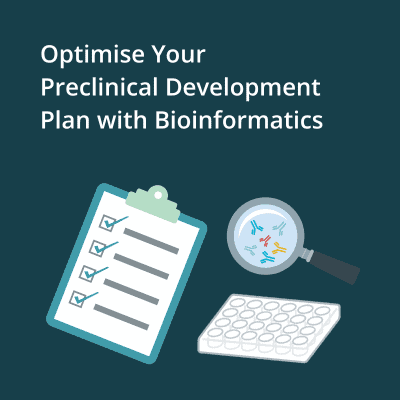Optimise Your Preclinical Development Plan with Bioinformatics
- 21st June 2024
- Posted by: Breige McBride
- Category: Bioinformatics

Strategic use of bioinformatics to optimise your preclinical development plan for success can be extremely beneficial. Not only does it help ensure only the most promising drug candidates advance to clinical trials, it can also help with:
- Reducing costs
- Enhancing safety
- Improving efficacy
- Regulatory approval
This is because, by integrating computational analysis and statistical modelling, bioinformatics empowers you to make data-driven decisions at every stage of preclinical development.
Below, we look at how it helps with target identification and validation, accelerates lead optimisation, and supports regulatory approval submissions.
Preclinical Development Plan Stages that Benefit from Bioinformatics
Target Identification
Using bioinformatics approaches at this stage can help you quickly find the most promising target for your disease of interest. For example, bioinformaticians can use data landscaping to search for datasets and literature relevant to the disease. Then, they can use data mining techniques to pinpoint key pathways involved in disease progression, facilitating target identification.
To give an example, at Fios Genomics we have mined the Parkinson’s Progression Markers Initiative (PPMI) database for a client, to help identify drug targets. Also, we leverage data mining to investigate things like gene expression profiles, biological pathways, protein-protein interactions, and various other omics data types to discover potential drug targets.
Target Validation
We can also use data mining to analyse public datasets to understand disease mechanisms and optimise target validation. Understanding these mechanisms allows us to confirm the target’s relevance to the disease and how it can be modified to alter the disease. Also, analysis of in-house data can determine if your target behaves as expected. For instance, by analysing knockout models, CRISPR screens or gene expression data, we can learn how a target behaves once modified. In silico comparisons of the in-house data and public data can then be conducted to further validate the targets.
Lead Identification
Lead identification is another important part of your preclinical development plan you can optimise via bioinformatics. As well as being used to analyse biological data to pinpoint potential drug leads, bioinformatics can support the lead identification process in other ways. For example, we can use bioinformatics approaches to simulate drug-target interactions to predict efficacy and specificity.
Lead Validation
Bioinformatics can help optimise lead validation by facilitating comparisons between potential candidates. Such comparisons can be used to determine which candidate has the most favourable profile in terms of target engagement, efficacy, specificity etc. For example, comparing gene expression data from untreated models (to establish a baseline), models treated with one lead of interest and models treated with a different lead of interest, can provide valuable insights into lead mode of action.
Optimising Your Preclinical Development Plan to Achieve Regulatory Approval
Bioinformatics plays an important role in supporting regulatory submissions during preclinical development. It does this by providing computational evidence, predictive models and data interpretation.
The computational evidence that bioinformatics provides from data analysis and predictive models can demonstrate the efficacy, safety, and mechanism of action of drug candidates to regulatory agencies. What’s more, computational models can reduce the need for extensive animal testing by providing reliable predictions. This aligns with regulatory trends towards minimising animal usage while ensuring robust safety and efficacy assessments.
Also, bioinformatics facilitates regulatory submissions via the integration and interpretation of datasets from preclinical studies. This is because it enables comprehensive analyses of efficacy endpoints, biomarker validation, and safety parameters.
Optimise Your Preclinical Development Plan With Fios Genomics
Now that you understand how bioinformatics can optimise your preclinical development plan, your thoughts may be turning to implementing bioinformatics into your next plan. If you need support with this, Fios Genomics can help. We have been providing bioinformatic analyses to support preclinical and clinical development for over 15 years. Our large team of bioinformaticians comprises of experts in everything from autoimmune diseases to virology, we have industry-leading turn around times and our analysis reports attract a lot of positive feedback, as shown below:
Working with Fios Genomics was a pleasure from beginning to end, with my immensely helpful point of contact, Eleanore Irvine, always ensuring all the details were attended to. The final report, produced under enormous time pressure, was still one of the clearest, most comprehensible and complete statistical analyses I have seen, thanks to the talented staff. I will be happy to use Fios Genomics’ services again in future.
Steven Piccoli, Head, Biomarkers – Clinical Sciences, Sun Pharma Advanced Research Company (SPARC)
We are regular clients of Fios Genomics and we value their professionalism as well as their timing in providing high quality reports.
Dr Valentina Paloschi, Postdoctoral Researcher, TU München
Fios provide you with a very nice data package, that is fully interpretable and allows you to draw meaningful conclusions.
Dr David Moffat, Director of Chemistry at Macrophage Pharma
If you would like us to provide bioinformatic analyses to optimise your preclinical development plan, contact us today!
Author: Breige McBride, Content and Social Media Manager, Fios Genomics
Reviewed by Fios Genomics Bioinformatics Experts to ensure accuracy
You may also be interested in:
Bioinformatics for Preclinical Development

